The British had such a long colonial history in Jamaica (1655–1962) that we usually forget that the island was a Spanish colony for more than 150 years (1494-1655).
We forget, until we come across places like Savanna la Mar, Ocho Rios and Spanish Town. Nowhere else has the struggle for Jamaica played out on a grander scale than in Spanish Town.
Originally called Villa de la Vega (later Santiago de la Vega), Spanish Town was founded in 1534 and became the colony’s second capital in 1538 after Spain relocated the seat of its government from Sevilla la Nueva (New Seville was named capital in 1509).
The Spanish laid out the town with its plaza mayor the administrative center of the capital, which included the governor’s mansion, courthouse and a tavern.
When the British captured Jamaica in 1655, they put their stamp on the capital renaming it Spanish Town, redesigning it on a grid and filling it with Georgian structures.
The center was built on a square that is formed by the intersection of four streets – Adelaide (north), Constitution (south), White (east) and King (west). It is now called Emancipation Square.
Four important buildings, some in ruins, ring Emancipation Square: Rodney Memorial, the Old Courthouse, the Parish Council and the Old King’s House.
Rodney Memorial
Located on Adelaide Street on what was a Spanish tavern is the memorial commemorating British Admiral George Rodney, who defeated a French fleet that tried to invade the island in 1782.
The statue of Rodney, dressed like a Roman emperor, was created by John Bacon in 1801. Two canons flanking the statue were taken from the French ship. The country’s Archives is housed in the building behind the Memorial.
The Old Courthouse
Facing the Rodney Memorial, with the canons trained directly at it, is the old courthouse on Constitution Street, now mostly in ruins. The courthouse was built in 1819 on the site that housed a Spanish chapel and cemetery, and later a British armory. The courthouse was destroyed by fire in 1986.
House of Assembly
The House of Assembly, on White Street, was completed in 1762. It now houses the mayor’s office and the chambers of the St. Catherine Parish Council.
Old King’s House
Built in 1762 on the site of the Old Spanish Hall of Audience, King’s House, located on King Street, was the official residence of the governor of Jamaica until 1872 when the British relocated the capital and the governor’s residence from Spanish Town to Kingston.
Since there are two residences called King’s House, the Spanish Town residence is referred to as Old King’s House. Sadly, Old King’s House was destroyed by fire in 1925. Now only the front of the building remains.
Old King’s House is significant in Jamaica’s history. It was from its steps that the governor read the Emancipation Proclamation on August 1, 1834, which freed the country’s enslaved peoples.
Other Important Events in Spanish Town’s History:
- Calico Jack Rackham was tried and convicted in Spanish Town in 1720
- The treaty that gave Jamaica’s Maroons their autonomy was signed in Spanish Town in 1725.
- Captain William Bligh, who brought breadfruit to Jamaica, visited Spanish Town in 1793.
- Simon Bolivar, the influential political and military leader from Venezuela, visited the capital in 1815.
- In 1834, Governor Eyre read the Proclamation, which abolished slavery, on the steps of Old King’s House.
- In 1865, Paul Bogle was denied an audience with Governor Eyre after he marched from St. Thomas to Spanish Town to plead the case of the people of St. Thomas. This later lead to the Morant Bay Rebellion.
- Governor Eyre announced the suspension of the constitution following the Morant Bay Rebellion.
- Queen’s College, Jamaica’s first university was established at Old King’s House in 1883 and operated in Spanish Town for a year.
Spanish Town has also housed the Registrar General’s Department, the Island Record Office and Genealogical Centre, and the Supreme Court. The town has been occupied continuously for almost 500 years.
Linking up with Travel Photo Thursday, which Nancie at Budget Travel Sandbox organizes. Be sure to head over and check out more photos from locations around the world.

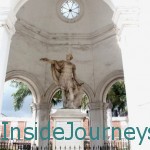
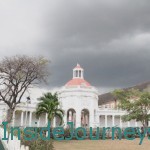

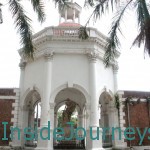
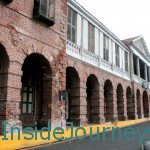
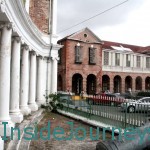
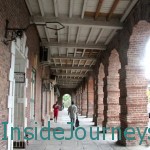
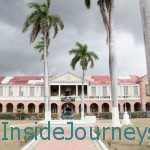


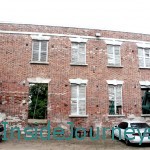
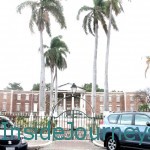
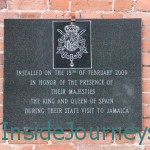
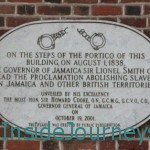









Very beautiful city…
Hey, I never knew all that. It hadn’t occurred to me that the Spanish were the first European colonists. Very much enjoyed reading the history of your island home, well, a very small part of it. William Bligh is also very well known here in Australia, of course. Our countries’ histories intersect in him!
Oh my goodness, what an interesting post, Marcia. Loved the history and the photos. (Sorry I missed Foodie Tuesday this week – we were on the road; I’ll do better next week!)
500 years is a long time. Having had both Spanish and English Occupations makes for a rich history. Having a Plaza Mayor and Georgian houses – what a mixture.
Interesting bit of history nicely illustrated with photos.
One of the first Jamaican towns I learned of is Ocho Rios, yet it somehow never occurred to me to wonder why it has a Spanish name. Looking at the photos, I definitely see the British influence in the architecture. Penang was a British colony for about 200 years. I guess that’s why they said “the sun never sets on the British empire.” They certainly got around.
Spanish Town has always sounded so romantic to me, in a pirate kind-of-way.
Wow, such interesting history Marcia, and the Spanish influence is visible in the architecture. Love hearing about all these places that I really have so little knowledge of. Thanks for sharing your knowledge here 🙂
Hi Marcia, I always associate Jamaica with British but I wasn’t aware that the Spanish colonized it, too (not surprised though). Quite a lot of history in Spanish town and beautiful architecture, too. I particularly like the House of Assembly with its stunning colonnaded facade.
Hi Marcia…Thanks for the interesting history lesson. I have to say that I didn’t know the British had such an influence on your country. Then again, way back then they were everywhere! 🙂
What an incredible history there in Jamaica. I knew it was old, but didn’t know of that. Gives me a lot to know and a lot of places to visit.
I love learning the history behind all these pretty houses, Marcia. I think you would make such an excellent tour guide!:-)
Thanks for sharing some of the detailed history of Spanish Town which I’ve passed through a few times without really understanding its Spanish connection.
I always learn so much from you about Jamaica. I didn’t realize the Spanish influence but what a very interesting post filled with so much history and information. Those buildings are beautiful!
Thanks, Anwar. We don’t usually think of the islands having a long history but they definitely do.
Thanks for the visit. Hope you make it here one of these days.
Thanks, Jess. Great idea! I’ll definitely give it some thought.
Hey Dana, haven’t ‘seen’ you in a while. Glad to hear you’ve passed through Spanish Town.
Hope you’ll stop next time — it’s really an interesting and unique town. Talk soon.
Just discovered your site – it’s awesome! I just followed you on Google+ – hope you have a moment to check out MightyTravels – we post every day to save travelers money. Looking forward to connect!
Thanks so much. Have followed you on Google as well.
Thanks for saying that, Mary. Yes, the Spanish was here too.